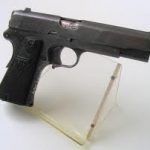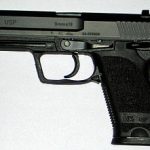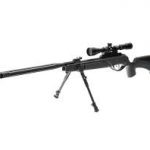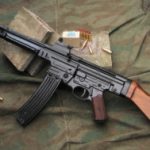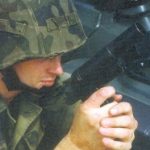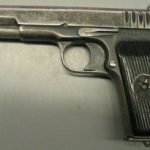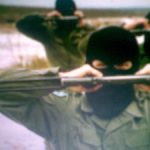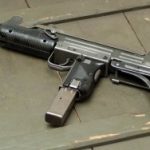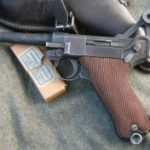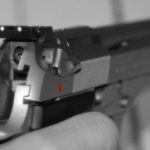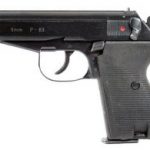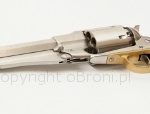MP 40.
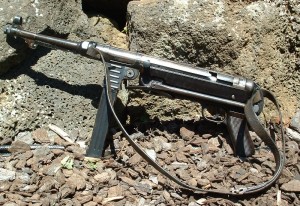
Produkcja rzędu 1 miliona egzemplarzy, nabój 9 x 19 mm Parabellum, 4 kilogramy odpowiednio zgrzanej stali i 500 strzałów na minutę szybkostrzelności teoretycznej. To wszystko przedstawia nam obraz „maschinenpistole 40”, w skrócie MP 40, a po polsku to najzwyczajniej pistolet maszynowy.Była to konstrukcja jak na tamte czasy nowoczesna, ale niestety dość kłopotliwa i skomplikowana w produkcji. Jak na swoją kategorię była po prostu dość ciężka, a najbardziej kłopotliwym w produkcji elementem broni była komora zamkowa. Skomplikowana technologia powodowała, że do końca 1940 roku wyprodukowano zaledwie 40 000 egz. wersji poprzedzającej Mp 40, czyli MP 38. Było to o wiele za mało jak na potrzeby stale rozwijającego się Wehrmachtu. Zasilanie odbywa się z dwurzędowego, charakterystycznie długiego magazynka pudełkowego o pojemności 32 naboi, z jednorzędowym wyprowadzeniem (wymienny z magazynkiem od MP38). W tym przypadku przycisk zatrzasku magazynka umieszczono z lewej strony gniazda. Początkowo magazynki posiadały gładkie boczne ścianki (dokładnie tak samo jak magazynki z MP38), natomiast później stosowano specjalne magazynki z przetłoczeniami zwiększającymi ich sztywność. Samo gniazdo magazynka znajduje się na dole komory zamkowej przed chwytem pistoletowym, nie posiada żadnych otworów stosowanych w celu zmniejszenia masy. Wiązało się to z kolejnym procesem produkcji, na który pod presją czasu i sporego zapotrzebowania nie można było sobie pozwolić. Do tylnej części szkieletu chwytu pistoletowego specjalnie zamontowano metalową kolbę składaną pod komorę zamkową. Bardzo przydatna podczas prowadzenia z wyczuciem użytkownika – ognia pojedynczego na dalsze odległości. Po lewej i prawej stronie chwytu pistoletu znajdują się okładki wykonane ze zwykłego bakelitu. Łoże, oraz okładki chwytu przeważnie charakteryzowały się kolorem czarnym, jednak spotykane są również egzemplarze wyposażone w łoże i okładki wykonane w kolorze brązowym. Sama produkcja MP40 była prostsza i szybsza niż produkcja MP38, jednak nowo stworzona broń charakteryzowała się większą masą w porównaniu do swojego poprzednika. Oczywiście pistolet posiada mechanizm spustowy umożliwiający strzelanie jedynie ogniem ciągłym, jednak ze względu na niewielką szybkostrzelność teoretyczną, oddanie pojedynczego strzału nie powinno dla nikogo stanowić większego problemu. W kolejnym modelu, o jeden numer wyższym od MP 40, a mianowicie MP 41 „Schmeisser”, oddanie pojedynczego strzału, przy prędkości teoretycznej wyższej o 100 strzałów na minutę (ok. 600strz./min.) nie byłoby już tak łatwe, jednak w porównaniu do radzieckiego PPSz (do 1000 strz./min.) i tak jeszcze wykonalne. Przejdźmy jednak do ciekawych modernizacji.
Jednym z praktycznych rozwiązań niemieckiej myśli technicznej jest to, iż broń może być wyposażona w „spust zimowy”, ułatwiający jego ściągnięcie w grubych zimowych rękawicach. Wygoda użytkowania, oraz brak zmarzniętych i skostniałych palców – przede wszystkim… Warto nadmienić, że MP 40 była produkowana również z myślą o spadochroniarzach mających w krótkim czasie i z zaskoczenia zdobyć wyznaczone cele. W tym przypadku mając do czynienia ze sporymi wysokościami (niskie temperatury) i potęgującym odczucia zimna pędowi powietrza, element ten staje się wręcz nieodzowny do przeprowadzenia sprawnego ataku. Mało tego, często strzelano nie tylko będąc już po bezpiecznym lądowaniu, lecz także trzepocząc na spadochronie, podczas opadania.
Kolejnym pomysłem było dostosowanie do broni odpowiedniego tłumika. Jednak naboje stosowane w serii MP były nieco inne niż w przeciętnych pistoletach. Mimo złudnego, tego samego pistoletowego 9×19 PARA, amunicję należało ładować zupełnie inną. A dokładniej mówiąc – mocniejszą. To właśnie dzięki niej niemieckie pistolety maszynowe były tak donośne, odczuwalnie odróżniając się od innego przeciętnego sprzętu tej klasy. Wracając do tłumików, niestety każdy prototyp wędrował w koszu, będąc najzwyczajniej rozerwany, bądź co najmniej pęknięty. Żadnemu z inżynierów nie udało się ujarzmić sporej mocy MP 40-stki. Akcje spadochronowe przeprowadzone w nocy z zaskoczenia, w połączeniu z wyciszonym strzałem broni automatycznej, jaką była MP 40, z pewnością spotęgowałyby efekty i zmniejszyłyby straty po stronie niemieckiej.
